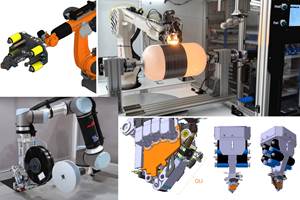Curing ovens ensure coverage of composite heating needs
CAMX 2024: Composite curing ovens by Wisconsin Oven provide a variety of features for comprehensive support, including temperature uniformity, energy efficiency, advanced controls and IoT, all backed by a dedicated team.
Share
Wisconsin Oven Corp. (East Troy, Wis., U.S.) is showcasing its high-performance composite curing ovens for vacuum bag, filament-wound and honeycomb block heating technologies. These curing ovens are used for manufacturing composite parts for a range of industries: Within aerospace, this includes parts such as wing structures, tails and fuselages. For the consumer industry, emerging technology continues to use composites for customer needs such as lightweight, but strong bike frames, automobile parts and fishing rods to baseball bats and underground storage tanks.
Wisconsin Oven’s composite curing ovens are available as gas-fired, indirect gas-fired or electrically heated. They are designed with specific features and options to meet the customer’s required heating technology. Options commonly used for composite curing ovens include data acquisition systems, thermal overdrive, vacuum systems and rotators. These ovens offer the following advantages:
- Temperature uniformity: Uniformity testing is performed on every oven prior to shipment, ensuring consistent curing and part quality, reducing scrap and rework. The Wisconsin Oven team are reported to be experts at AMS2750, BAC5620 and CQI-9 compliance.
- Energy efficiency: Patented oven designs minimize energy consumption and reduce operating costs. E-Pack energy efficiency packages are offered as an upgrade to further optimize energy consumption.
- Advanced controls: Intuitive interfaces and comprehensive data acquisition capabilities simplify operation and optimize curing cycles.
- Internet of Things (IoT) system availability: Data-Sense predictive maintenance technology remotely monitors the performance and health of equipment, preventing unexpected downtime, and increasing the equipment’s performance.
- Customer service: A dedicated team provides comprehensive support, from pre-sale consultation to startup, training and full turnkey installation.
Wisconsin Oven equipment is built to last. Standard oven lines are backed by the company’s exclusive 3- or 5-year Heat and Recirculation Warranty. Moreover, all equipment is adjusted and tested at the factory prior to shipment to reduce installation and startup time.
Related Content
-
PEEK vs. PEKK vs. PAEK and continuous compression molding
Suppliers of thermoplastics and carbon fiber chime in regarding PEEK vs. PEKK, and now PAEK, as well as in-situ consolidation — the supply chain for thermoplastic tape composites continues to evolve.
-
The next evolution in AFP
Automated fiber placement develops into more compact, flexible, modular and digitized systems with multi-material and process capabilities.
-
TU Munich develops cuboidal conformable tanks using carbon fiber composites for increased hydrogen storage
Flat tank enabling standard platform for BEV and FCEV uses thermoplastic and thermoset composites, overwrapped skeleton design in pursuit of 25% more H2 storage.
Related Content
PEEK vs. PEKK vs. PAEK and continuous compression molding
Suppliers of thermoplastics and carbon fiber chime in regarding PEEK vs. PEKK, and now PAEK, as well as in-situ consolidation — the supply chain for thermoplastic tape composites continues to evolve.
Read MoreThe next evolution in AFP
Automated fiber placement develops into more compact, flexible, modular and digitized systems with multi-material and process capabilities.
Read MoreTU Munich develops cuboidal conformable tanks using carbon fiber composites for increased hydrogen storage
Flat tank enabling standard platform for BEV and FCEV uses thermoplastic and thermoset composites, overwrapped skeleton design in pursuit of 25% more H2 storage.
Read MoreCarbon fiber, bionic design achieve peak performance in race-ready production vehicle
Porsche worked with Action Composites to design and manufacture an innovative carbon fiber safety cage option to lightweight one of its series race vehicles, built in a one-shot compression molding process.
Read MoreRead Next
Uavos delivers curing oven to aerocomposites manufacturer
Composite curing oven meets customer needs with ability to cure complex synthetic and composite parts.
Read MoreAll-recycled, needle-punched nonwoven CFRP slashes carbon footprint of Formula 2 seat
Dallara and Tenowo collaborate to produce a race-ready Formula 2 seat using recycled carbon fiber, reducing CO2 emissions by 97.5% compared to virgin materials.
Read More









